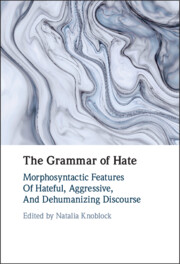Book contents
- The Grammar of Hate
- The Grammar of Hate
- Copyright page
- Contents
- Figures
- Tables
- Contributors
- Acknowledgments
- Introduction
- 1 Animacy and Countability of Slurs
- 2 Language Aggression in English Slang: The Case of the -o Suffix
- 3 Adj+ie/y Nominalizations in Contemporary English
- 4 Grammatical Gender and Offensiveness in Modern Greek Slang Vocabulary
- 5 Unseen Gender
- 6 The Neutering Neuter
- 7 Neutering Unpopular Politicians
- 8 The Power of a Pronoun
- 9 Is Play on Words Fair Play or Dirty Play?
- 10 Expressive German Adjective and Noun Compounds in Aggressive Discourse
- 11 ‘Kill the Invaders’
- 12 ‘I am no racist but …’
- 13 Homophobic Space–Times
- Index
- References
8 - The Power of a Pronoun
Published online by Cambridge University Press: 30 June 2022
- The Grammar of Hate
- The Grammar of Hate
- Copyright page
- Contents
- Figures
- Tables
- Contributors
- Acknowledgments
- Introduction
- 1 Animacy and Countability of Slurs
- 2 Language Aggression in English Slang: The Case of the -o Suffix
- 3 Adj+ie/y Nominalizations in Contemporary English
- 4 Grammatical Gender and Offensiveness in Modern Greek Slang Vocabulary
- 5 Unseen Gender
- 6 The Neutering Neuter
- 7 Neutering Unpopular Politicians
- 8 The Power of a Pronoun
- 9 Is Play on Words Fair Play or Dirty Play?
- 10 Expressive German Adjective and Noun Compounds in Aggressive Discourse
- 11 ‘Kill the Invaders’
- 12 ‘I am no racist but …’
- 13 Homophobic Space–Times
- Index
- References
Summary
Through the concept of performativity we can see how ‘the uttering of the sentence is, or is a part of, the doing of an action’. Language can influence cognitive processes and can highlight certain attributes or qualities of people. This chapter explores the role of pronoun choice as a dehumanizing discursive strategy. By using a pronoun that is normally related to non-human creatures in reference to a human being, the pronoun choice itself becomes the doing of the action of dehumanization. In languages where there are two sets of pronouns, one type is normally used to express personhood, and the other in reference to inanimate objects and to animals. When the inanimate pronoun it is used, the referent is not considered human. On the contrary, in previous research, I have shown that when the pronouns that express personhood are used in reference to humanoid creatures, they can take part in a humanization process that can have obvious consequences for the moral question of how to treat that creature. While the author’s previous research has concentrated on the literary and film application of the importance of pronoun, here conclusions from such research are revisited and ‘it-dehumanization’ examined in real-life discourse.
- Type
- Chapter
- Information
- The Grammar of HateMorphosyntactic Features of Hateful, Aggressive, and Dehumanizing Discourse, pp. 161 - 176Publisher: Cambridge University PressPrint publication year: 2022
References
- 2
- Cited by

